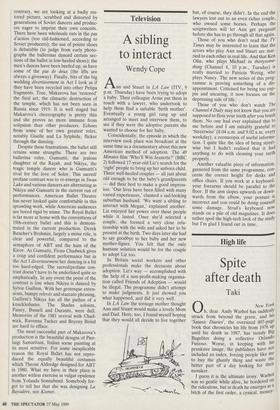Dance
La Bayadere (Royal Opera House)
Lavish orientalia
Deirdre McMahon
La Bayadere is in many ways the paradigm of 19th-century ballet spectacle. If one reads the libretto and contemporary accounts, the production sounds like a Cecil B. de Mille epic. The mythic Indian mise-en-scene enabled the choreographer, Marius Petipa, to indulge to the full his taste for lavish orientalia. However, the ballet has survived not just on the strength of its spectacle. It was first performed in 1877, the year of the Moscow premiere of Swan Lake, and in one seminal act, the Kingdom of the Shades, La Bayadere looks forward to the Petipa-Ivanov Swan Lake in 1895 and its choreographic symphonism.
La Bayadere continued to be performed in Russia but was unknown in the West until 1961 when the Kirov performed it in Europe and America. In 1963 Rudolf Nureyev staged his landmark production of the Shades scene for the Royal Ballet. In 1974 another Kirov defector, Natalia Makarova, staged her version of the Shades for American Ballet Theatre and followed this up six years later with the first full-length production ever seen in the West, also for Ballet Theatre. It is this production, with minor revisions, which Makarova has now restaged for the Royal Ballet.
Revisions, ay, there's the rub. Makar- ova's production is not an authentic recon- struction of the Petipa original; on the contrary, we are looking at a badly res- tored picture, scrubbed and distorted by generations of Soviet dancers and produc- ers eager to imprint their own conceits. There have been wholesale cuts in the pas d'action (too old-fashioned, according to Soviet producers); the use of pointe shoes is debatable (to judge from early photo- graphs the ballerinas danced certain sec- tions of the ballet in low-heeled shoes); the men's dances have been beefed up, as have some of the pas de deux (the lifts are always a giveaway). Finally, bits of the big wedding divertissement in Act I look as if they have been recycled into other Petipa fragments. True, Makarova has 'restored' the final act, the climactic destruction of the temple, which has not been seen in Russia since 1919. It is well staged but Makarova's choreography is pretty thin and she proves no more immune from solipsism than other producers. Echoes from some of her own greatest roles, notably Giselle and La Sylphide, flicker through the dancing.
Despite these frustrations, the ballet still retains some strengths. There are two ballerina roles, Gamsatti, the jealous daughter of the Rajah, and Nikiya, the tragic temple dancer who is Gamsatti's rival for the love of Solor. This sacred/ profane contrast was to re-emerge in Swan Lake and various dancers are alternating as Nikiya and Gamsatti in the current run of performances. American Ballet Theatre has never looked quite comfortable in this sprawling work, while American audiences are bored rigid by mime. The Royal Ballet is far more at home with the conventions of 19th-century ballet and this is demons- trated in the current production. Derek Rencher's Brahmin, largely a mime role, is clear and powerful, compared to the semaphore of ABT and the ham of the Kirov. As Gamsatti, Fiona Chadwick gives a crisp and confident performance but in the Act I divertissement her dancing is a bit too hard-edged. The sacred/profane con- trast doesn't have to be underlined quite so emphatically. In any event the point of the contrast is lost when Nikiya is danced by Sylvie Guillem. With her grotesque exten- sions, bumpy releves and staccato phrasing, Guillem's Nikiya has all the pathos of a knuckleduster. The Shades soloists, Paisey, Bussell and Durante, were dull. Memories of the 1981 revival with Chad- wick, Ravenna Tucker and Bryony Brind are hard to efface.
The most successful part of Makarova's production is the beautiful designs of Pier- luigi Samaritani, Italian scene painting at its most sensitive. For some inexplicable reason the Royal Ballet has not repro- duced the equally beautiful costumes which Theoni Aldredge designed for ABT in 1980. What we have in their place is another witless exercise in vulgar opulence from Yolanda Sonnabend. Somebody for- got to tell her that she was designing La Bayadere, not Kismet.



















































 Previous page
Previous page